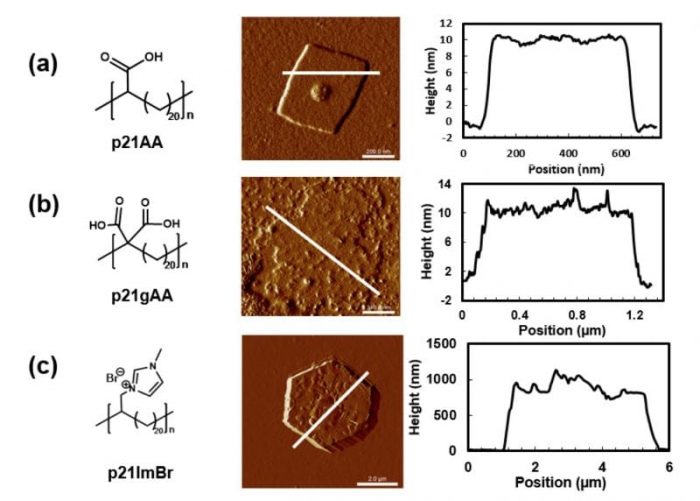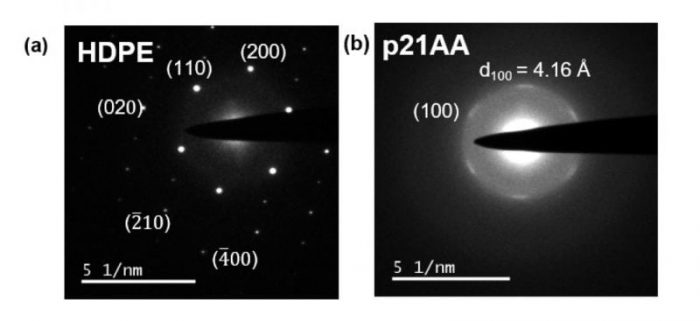
Polyolefins, especially polyethylene (PE), are the most prevalent class of polymers in the world due to their broad range of applications, from packaging, agriculture, construction, healthcare, safety apparel, and transportation. Consequently, fundamental research on PE, like crystallization, is valuable and can lead to significant improvements in material properties and new products.
To study the crystallization and crystal structures of PE-based materials, growing polymer single crystals from dilute solutions is a commonly-used method. PE single crystals grown from dilute xylene solution exhibit lozenge shape and the growth front corresponds to the (110) planes of the orthorhombic crystal lattice. The lamella thickness is on the order of 10nm, in which the polymer chains are folded back and forth on themselves at the top and bottom surfaces of the crystal. However, the crystal structure of PEs with associating groups (e.g. acid or ionic groups) hasn’t been well studied. Here, in this work, we prepare crystals of precise acid- and ion-containing PEs from dilute solution and investigate their crystal motifs, unit cell structures, and chain conformations.
Even though containing bulky associating functional groups, these polymers can grow into well-defined crystals evidently shown in atomic force microscopy (AFM) measurement. The thickness of p21AA and p21gAA solution-grown crystals is on the order of 10 nm, similar to PE solution-grown crystals. While p21ImBr solution-grown crystals are not only much larger in the lateral dimension, but in thickness (~ 500nm), which suggests a novel chain conformation within these crystals.

Figure 1. Chemical structure, AFM amplitude image, and height corresponding to the white line in AFM image of (a) p21AA, (b) p21gAA, and (c) p21ImBr. (Image credit: Lu Yan)
To determine the crystal unit cell structure, electron diffraction data of solution-grown crystals were collected. Studies of high-density polyethylene (HDPE) were made in conjunction with the acid copolymers as a means of having a standard, highly-studied sample with which to compare. The strong diffraction spots in the HDPE data correspond to {110} and {200} reflections from orthorhombic crystal structure with p21AA, on contrast, shows a hexagonal crystal structure.
This crystal structure of p21AA appears similar to the pseudohexagonal phase of PE, which forms at high pressure or high temperature upon melting in which the methylene segments are more disordered. Raman spectra of these crystals also suggest a higher level of disorder chain conformations existing within precise acid- and ion-containing PEs than HDPE.

Figure 2. (hk0) electron diffraction data of solution-grown crystals. (a) (b) Parallel beam electron diffraction of PE single crystal, and p21AA crystal. (Image credit: Lu Yan)
There are three possible chain conformations for a solution-grown crystal of precise PEs. The thin crystal expel the pendant groups to the crystal surfaces leaving the single crystal thickness close to the alkyl spacer length between the pendant groups. Because the crystal thicknesses (as measured by AFM) of the precise PEs with associating pendant groups are much larger than the all-trans length of 21 CH2 units (2.5 nm), the thin crystal motif doesn’t apply to these solution-grown crystals.
The second type is crystals with extended chain conformation, in which pendant groups are incorporated into the crystals and chains only fold at crystal surfaces. However, these associating pendant groups are atactic and too large to be incorporated into the crystals. A new chain conformation was found to be adapted in these three precise acid- and ion-containing PEs, in which polymer chains tightly fold near the functional groups and stacked into multiple layer assemblies. This novel chain conformation provides promising channels for fast ion or proton transport within the crystalline region of PE-based materials.
These findings are described in the article entitled Solution-grown crystals of precise acid- and ion-containing polyethylenes, recently published in the journal Polymer. This work was conducted by Lu Yan and Karen I. Winey from the University of Pennsylvania, and Karen C. Bustillo, Ouliana Panova, and Andrew M. Minor from Lawrence Berkeley National Laboratory.








